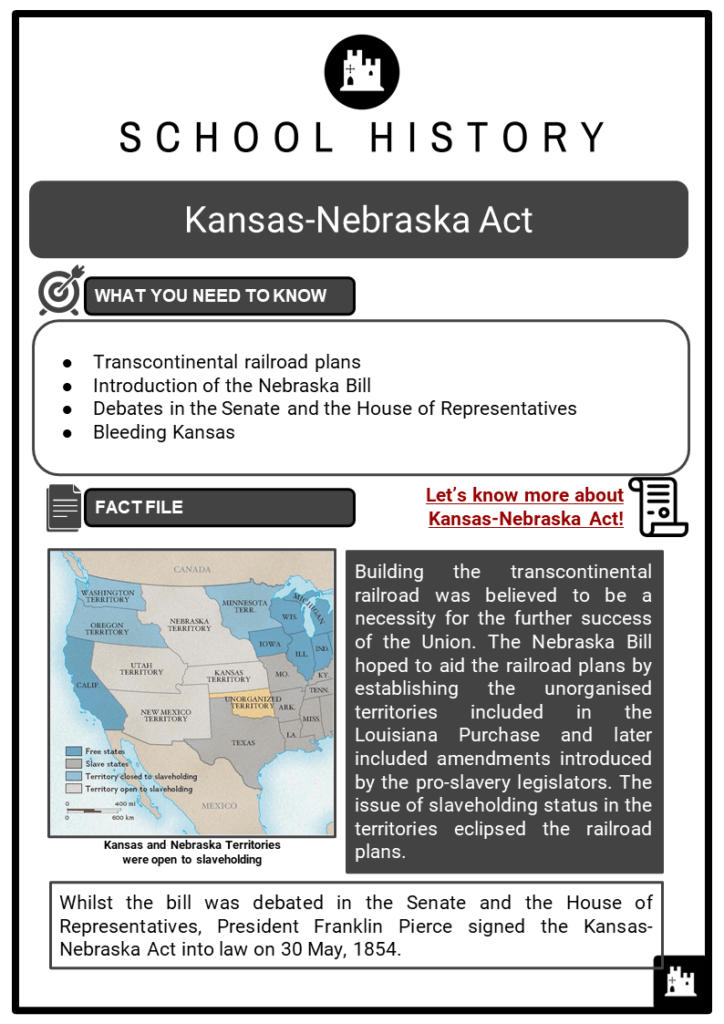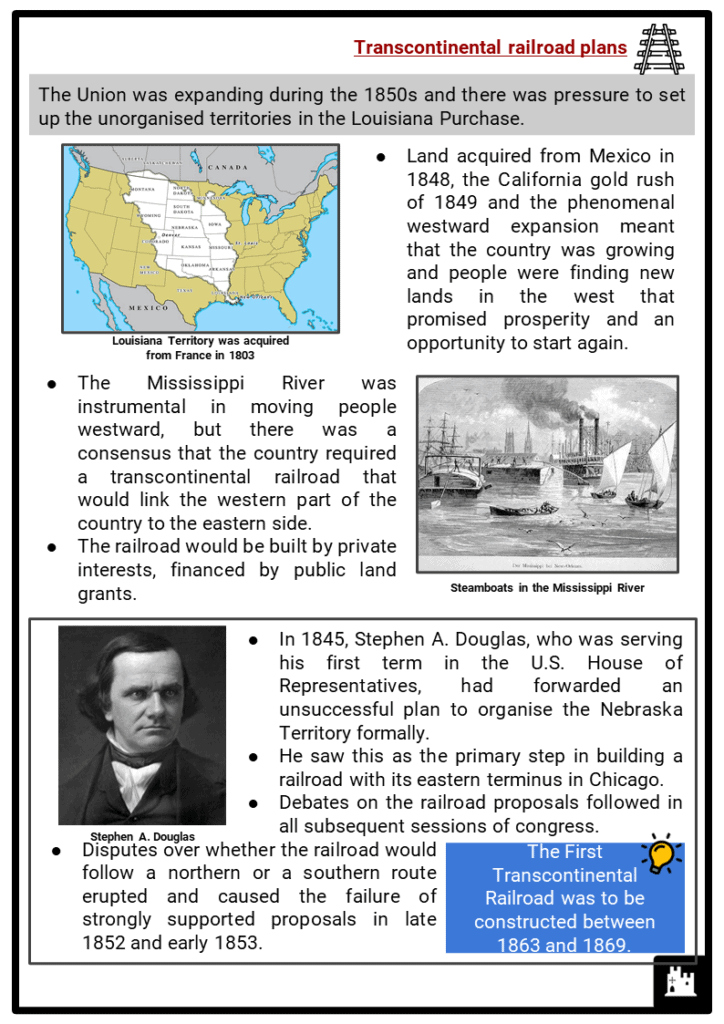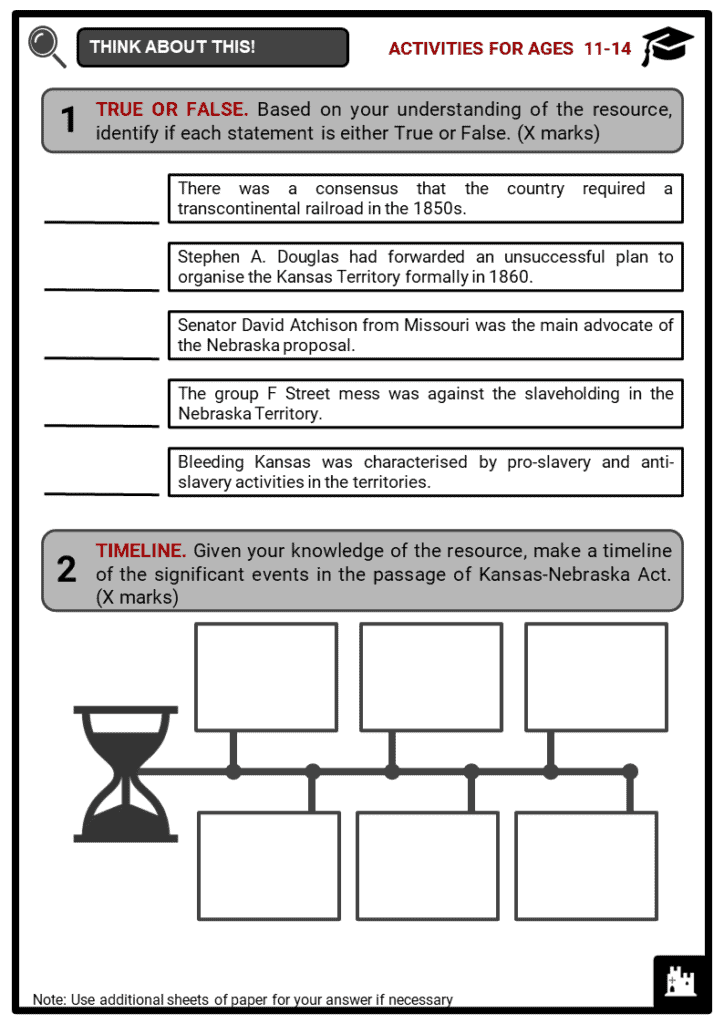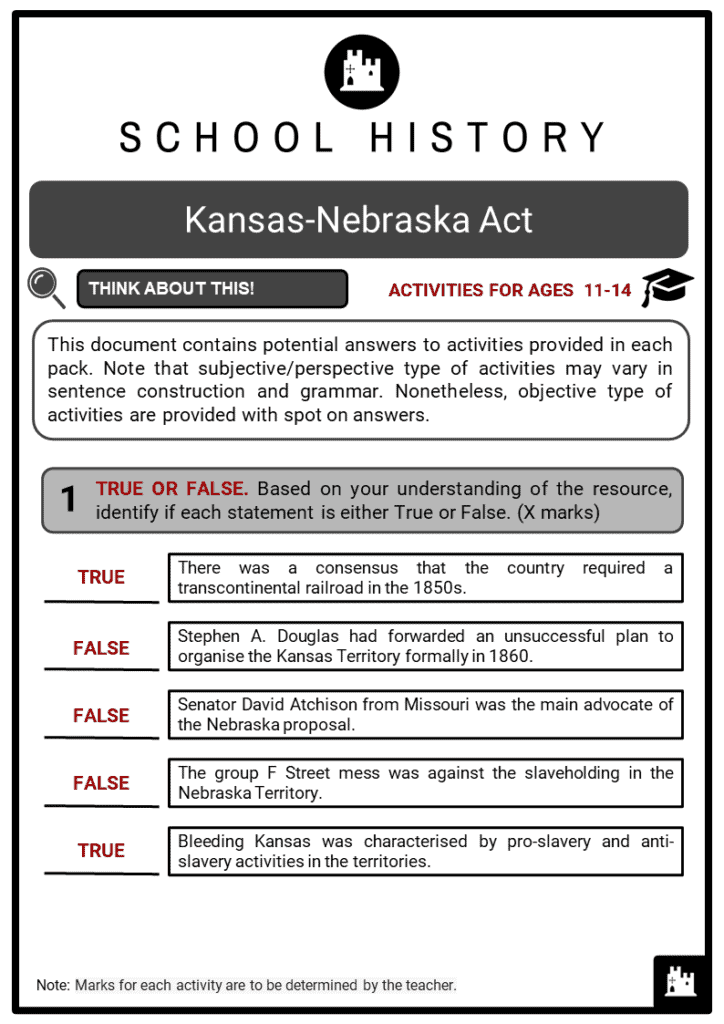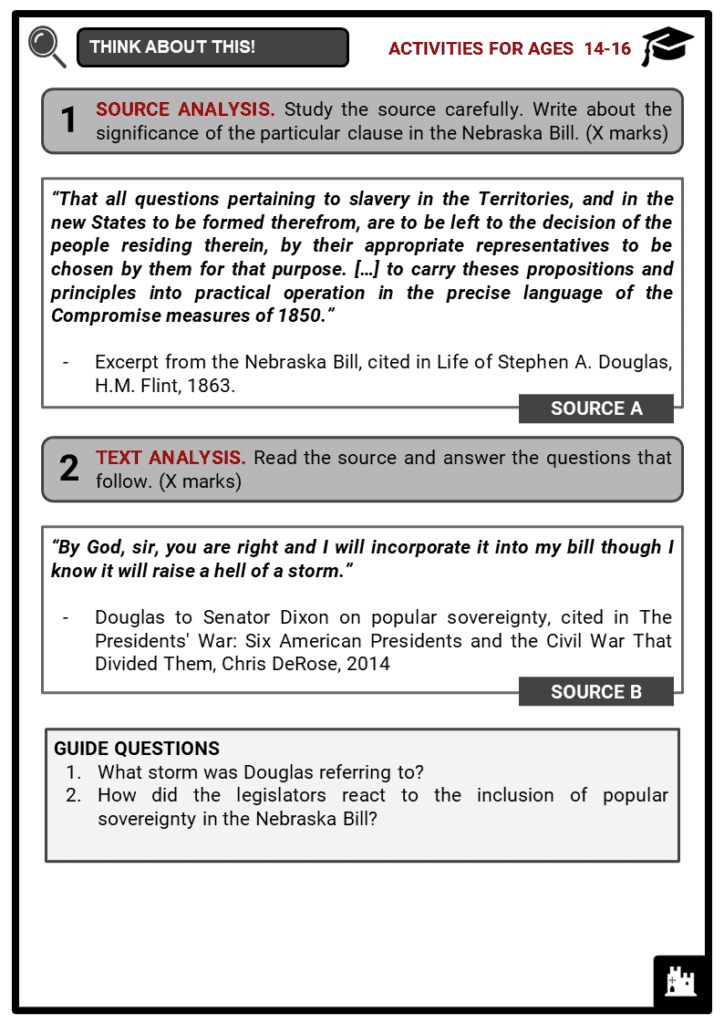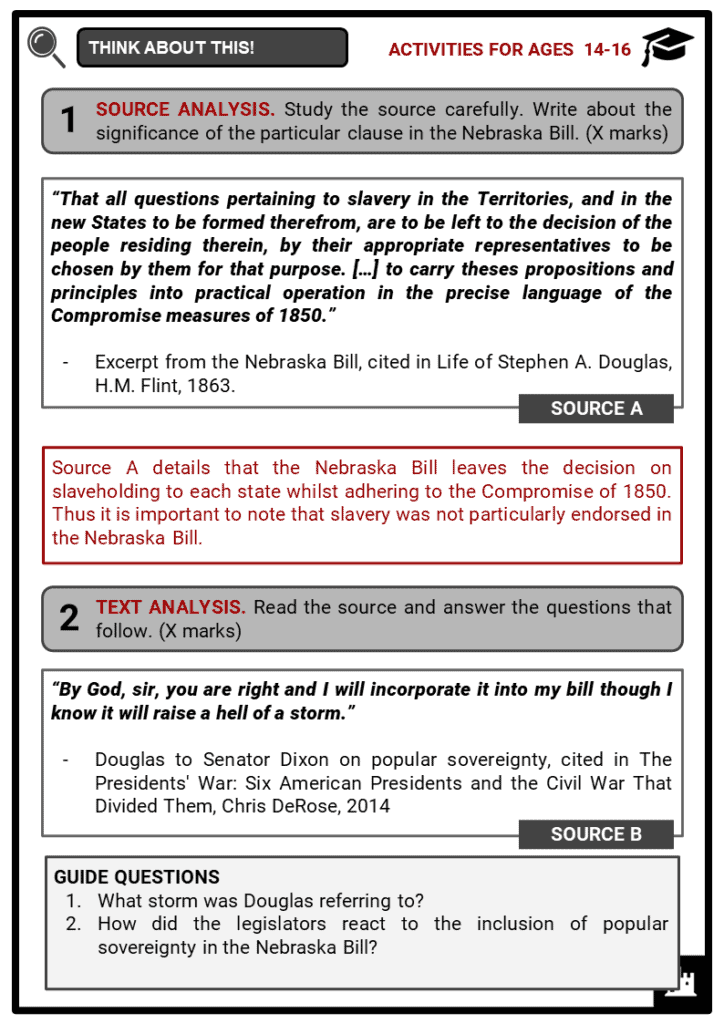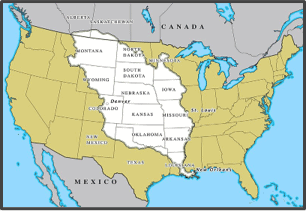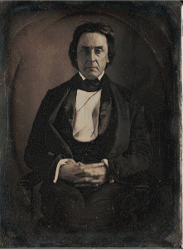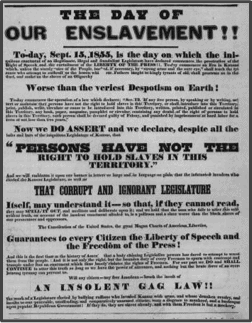Download Kansas-Nebraska Act Worksheets
Do you want to save dozens of hours in time? Get your evenings and weekends back? Be able to teach Kansas-Nebraska Act to your students?
Our worksheet bundle includes a fact file and printable worksheets and student activities. Perfect for both the classroom and homeschooling!
Table of Contents
Add a header to begin generating the table of contents
Summary
- Transcontinental railroad plans
- Introduction of the Nebraska Bill
- Debates in the Senate and the House of Representatives
- Bleeding Kansas
Key Facts And Information
Let’s know more about Kansas-Nebraska Act!
- Building the transcontinental railroad was believed to be a necessity for the further success of the Union. The Nebraska Bill hoped to aid the railroad plans by establishing the unorganised territories included in the Louisiana Purchase and later included amendments introduced by the pro-slavery legislators. The issue of slaveholding status in the territories eclipsed the railroad plans.
- Whilst the bill was debated in the Senate and the House of Representatives, President Franklin Pierce signed the Kansas-Nebraska Act into law on 30 May, 1854.
Transcontinental railroad plans
- The Union was expanding during the 1850s and there was pressure to set up the unorganised territories in the Louisiana Purchase.
- Land acquired from Mexico in 1848, the California gold rush of 1849 and the phenomenal westward expansion meant that the country was growing and people were finding new lands in the west that promised prosperity and an opportunity to start again.
- The Mississippi River was instrumental in moving people westward, but there was a consensus that the country required a transcontinental railroad that would link the western part of the country to the eastern side.
- The railroad would be built by private interests, financed by public land grants.
- In 1845, Stephen A. Douglas, who was serving his first term in the U.S. House of Representatives, had forwarded an unsuccessful plan to organise the Nebraska Territory formally.
- He saw this as the primary step in building a railroad with its eastern terminus in Chicago.
- Debates on the railroad proposals followed in all subsequent sessions of congress.
- Disputes over whether the railroad would follow a northern or a southern route erupted and caused the failure of strongly supported proposals in late 1852 and early 1853.
- Democratic Senator David Atchison from Missouri made it clear that his support for the Nebraska proposal was conditional – he wanted slaveholding to be permitted in the territories that were to be organised.
- The bill did not tackle the topic of slavery, but the Missouri Compromise, in effect since 1820, prohibited slavery in territory north of 36°30' latitude and west of the Mississippi River.
- The railroad issue was pushed behind by the issue of repeal of the Missouri Compromise.
- The group F Street mess, which consisted of Atchison, Robert T. Hunter (from Virginia, chairman of the Finance Committee), James Mason (from Virginia, chairman of the Foreign Affairs Committee) and Andrew P. Butler (from South Carolina, chairman of the Judiciary Committee), insisted on slaveholder equality in Nebraska when Congress reconvened on 5 December 1853.
- In response to Atchison’s insistence, Douglas then proposed that the Compromise of 1850, which was applied in Utah and New Mexico Territories, should be used in Nebraska, in which slavery was not particularly restricted.
- Utah and New Mexico were not part of the Louisiana Purchase which was governed by the Missouri Compromise. The Compromise of 1850 superseded the Missouri Compromise.
Introduction of the Nebraska Bill
- In January 1854, Senator Douglas introduced a bill proposing to organise the Nebraska Territory, the area occupied by present-day Kansas, Nebraska, Montana, South and North Dakota, “with or without slavery, as their constitutions may prescribe”, introducing a concept known today in popular parlance as popular sovereignty.
- Douglas did not deal with the issue of slavery directly thus the bill failed to work.
- However, Kentucky Whig Archibald Dixon surprised Douglas with an amendment to the bill: the section of the Missouri Compromise that prohibited slavery north of the 36°30' parallel had to be repealed.
- Douglas reluctantly agreed.
- Philip Phillips of Alabama suggested a similar amendment and they arranged to meet with President Franklin Pierce.
- The president and his cabinet proposed an alternative plan to Douglas, fearing that repealing the Missouri Compromise would cause serious political problems.
- However, Atchison’s group, who were adamant in pushing the repeal in favour of slavery, accompanied Douglas in another meeting with the president.
- This time, Pierce was persuaded to support the Nebraska bill with the proposed amendments.
Debates in the Senate and in the House of Representatives
- The revised bill was introduced to the Senate on 23 January.
- Amendments consisted of:
- Repeal of the Missouri Compromise
- Territory would be divided into Kansas and Nebraska
- Popular sovereignty was allowed
- The bill had its supporters and critics.
- The debate over the revised bill continued for four months.
- Senator Salmon P. Chase, William Seward of New York, and Charles Sumner of Massachusetts led the opposition whilst Douglas remained the lead advocate for the bill.
- Senate concluded on 4 March 1854 with a final vote in favour of passage 37 to 14.
- The debate in the House was delayed for a few months but was intense when it started on 8 May.
- The opponents gave their all in fighting against the bill despite the certainty of its passage.
- The final House vote in favour of the bill was 113 to 100.
- An Act to Organize the Territories of Nebraska and Kansas, which was later known as the Kansas–Nebraska Act, was signed into law by President Franklin Pierce on 30 May, 1854.
- Former Illinois Representative Abraham Lincoln gave his most comprehensive argument against slavery and the provisions of the Kansas-Nebraska Act in Peoria, Illinois, on 16 October, in the Peoria Speech.
Bleeding Kansas
- Besides the Act repealing the Missouri Compromise, creating two new territories, and allowing popular sovereignty, it also produced a violent uprising called the ‘Bleeding Kansas’.
- Bleeding Kansas was characterised by pro-slavery and anti-slavery activities in the territories attempting to sway the public votes in accordance with their stance on slavery.
- Political turbulence devastated what was left of the Old Whig Party, and the Republican Party was born.
- The tensions of the time are often thought of as the prelude to the Civil War.
- To sway the voting in Kansas, some Missouri residents crossed the border to vote in Kansas and became known as border ruffians.
- Border ruffians contributed to a pro-slavery legislature in Kansas which drafted a pro-slavery constitution referred to as the Lecompton Constitution.
- The Lecompton Constitution protected the institution of slavery and contained provisions that excluded free blacks from its bill of rights.
- In 1856, John Brown and his four sons had declared themselves as “appointed by God to confront the evil of their time.”
- They got wind of news that some anti-slavery activists were attacked at Lawrence Kansas.
- John and his sons went into Pottawatomie Creek, attacked the residents and captured and killed James Doyle and his sons, despite the fact that they were not involved in the attacks in Lawrence.
- In Congress in the same year, Senator Charles Sumner gave a speech titled “Crime against Kansas” and in it he insulted pro-slavery legislator Andrew Butler, comparing slavery to prostitution.
- He stated that Butler’s position on slavery was that of a man avowed to “a mistress though ugly to others, is lovely to him; though polluted in the sight of the world, is chaste in his sight. I mean the harlot Slavery.”
- Butler’s nephew Senator Preston Brooks cornered Sumner and caned him, leaving him physically and mentally incapacitated for a very long time.
- In 1859, John Brown led another attack in which he attempted to raid the federal armoury at Harper’s Ferry in Virginia. The raid was stopped by General Robert E. Lee, who went on to become the commander of the Confederate Army during the Civil War.
- Eventually, Kansas was admitted as a free state in 1861.
Image sources:

